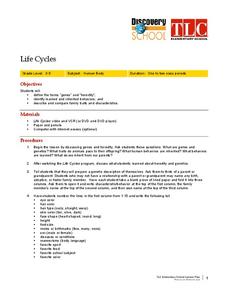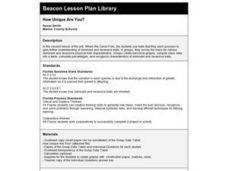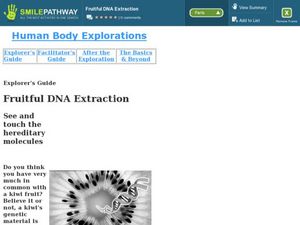Curated OER
A Priceless Collection
Students read about and discuss life of Russian geneticist Nikolai Vavilov, define terms related to field of genetics, complete worksheets, conduct seed experiments, observe and record results, and locate seed banks on world map or globe.
Curated OER
Adrenoleukodystrophy (ALD):A Case Study Using the Film
Students study the genetic disorder Adrenoleukodystrophy (ALD) by viewing the film "Lorenzo's Oil". They complete a summary of the movie and answer questions while viewing the movie. Extensions activities also included.
Curated OER
Monohybrid Punnetr Squares
Students explore Punnett squares and illustrate specific genotypic and phenotypic genetic outcomes. After a class discussion, students predict the probability of a specific trait being passed on by using Punnett squares. They reveal the...
Curated OER
Life Cycles
Students identify inherited traits. In this heredity lesson, students watch a video and construct a genetic description of themselves.
Curated OER
How Does a Pedigree Help Us to Trace a Trait That is Inherited?
Students analyze genetic patterns. In this pedigree lesson, students determine dominant or recessive inheritance. They construct a human pedigree from genetic information.
Curated OER
Genes
Young scholars explore the history, inheritance and mutations of genetics. In this genetic lesson students complete experiments on DNA sequences.
Curated OER
How Unique Are You?
Students explore how genetic information is passed down from parent to offspring. Because of this, they examine how this causes the variation in each species.
Curated OER
Genes Count
Students view a video that reviews Mendelian genetics. They discuss the Hardy-Weinberg Law and use Popsicle sticks to simulate genetic variations and ratios in offspring.
Curated OER
Fun with Heredity
Learners explore basic concepts of heredity and collaborate to see genetics in action through several activities provided in the instructional activity. Inherited traits are examined and identified as dominant or recessive.
Curated OER
Genes and Inheritance
Young scholars explore genes and inheritance. After listening to a story describing a rare genetic disease, students discuss inheritance and how living things pass on traits to their children. In groups young scholars, students...
Curated OER
Regulating Gene Expression
In this genes worksheet, students review the system that controls gene expression and the enzymes required for regulating genetic expression. This worksheet has 6 fill in the blank and 7 short answer questions.
Curated OER
Human Body Explorations
Students examine genetics and the DNA of a kiwi. In this DNA lesson students complete a lab to extract DNA and interpret their results.
Curated OER
Birth Defects
Students discuss problem pregnancies and birth defects. They identify which birth defects are preventable and which ones are genetic, or inherited. They prepare reports on birth defects.
Curated OER
50:50 Chances
Third graders reinforce the probability of gender by uising a coin toss, as they continue to search for the answers to genetics questions by using mathematical expectations of probability.
Curated OER
How Do Organisms Vary?
Students study variation of organisms. They determine this variation arises from genetic and environmental causes.
Curated OER
Cancer as a Multistep Process
Pupils analyze the causes of cancer from a genetic standpoint. They explain the increase in cancer with age and create a hypothesis for cancer development. They use the laws of probability as well.
Other popular searches
- Genetic Engineering
- Genetic Diseases
- Population Genetics
- Genetics Worksheets
- Mendelian Genetics
- Genetics Middle School
- Genetics Probability
- Genetic Traits
- Genetics & Punnett Squares
- Genetics and Heredity
- Genetic Mutations
- Genetic Drift

















